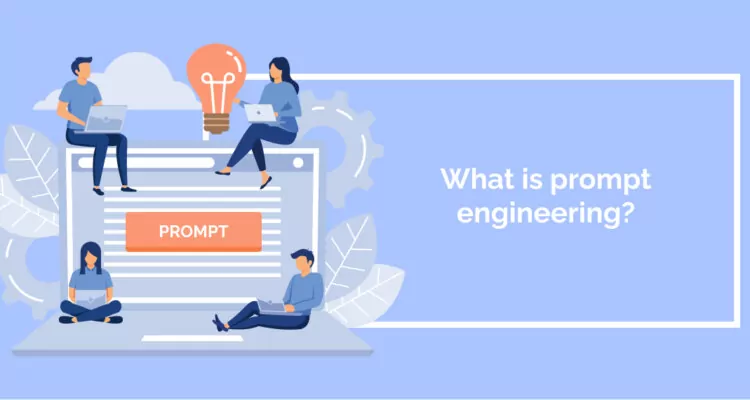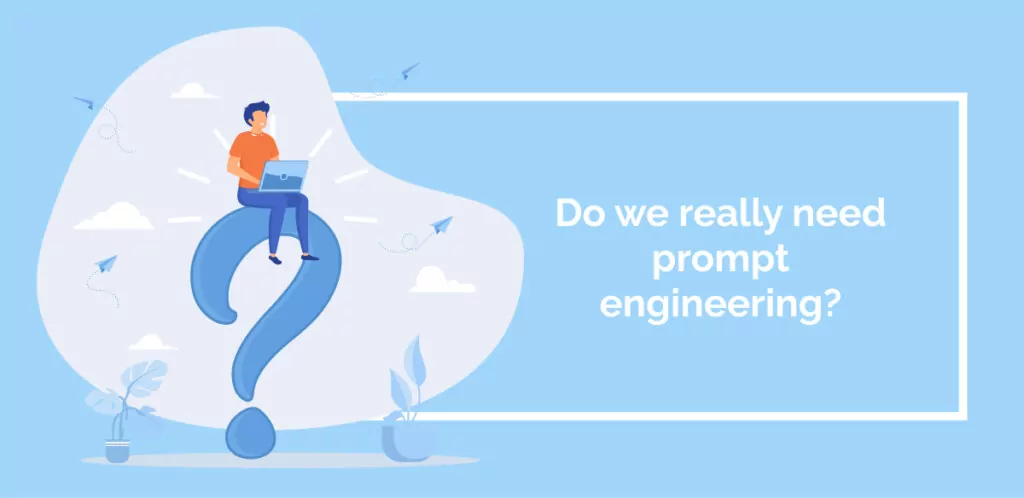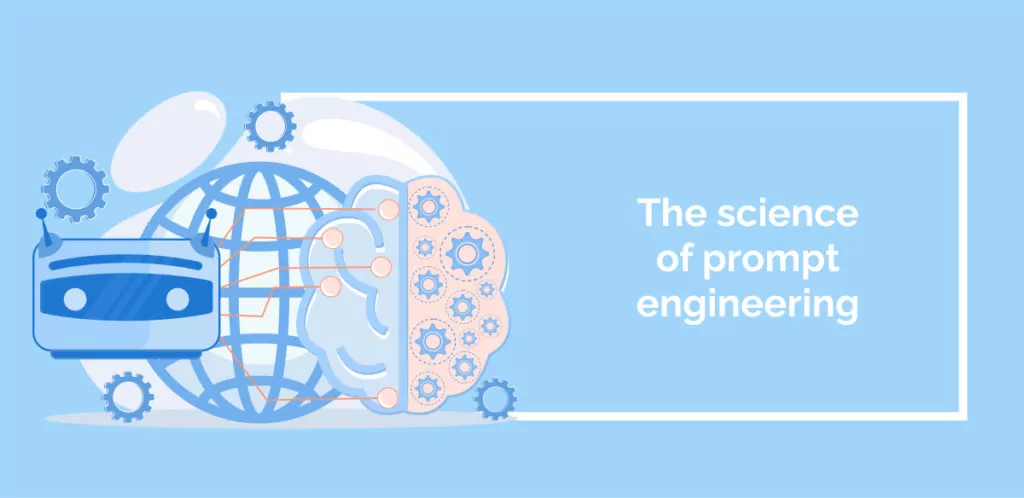
It’s a funny moment in the history of AI. On the one hand, generative AI tools are everywhere, rendering human-like text. All users are getting more comfortable with the idea of trusting the computer with their needs. And most of the time, they get something like their desired response.
On the other hand, these AI tools are already becoming professionalized. The field of prompt engineering has opened up thanks to smart AI users with a tech background building a better understanding of prompts. Professional prompt engineers are advertising their services, sometimes at eye-watering prices. Their promises of huge business growth from AI are intriguing – but is this job role likely to last a long time?
If all this is new to you, this article is here to help. We will introduce the topic of prompt engineering so that anyone can understand it.
- The article will start by defining prompt engineering
- Then, we’ll explain why prompt engineering is necessary
- The article will then examine a few examples of prompt engineering in practice
- And finally, it will explain some underlying techniques for making the best out of prompts.
Undoubtedly, AI should be a part of your workplace automation strategies. So read on to find out how prompt engineering can help.
Prompt Engineering: a definition
Prompt engineering is the process of crafting effective and precise instructions for AI language models.
Although generative Large Language Models are intuitive to use, the outputs’ quality often depends on how users ask their questions. End users can maximize the system’s capabilities by asking the right questions. Some simple examples include prompting it to think step-by-step, ask for clarification, or generate creative and contextually relevant responses.
Effective prompt engineering uses skills that aren’t always technical. Prompt engineering requires an understanding of the AI model’s strengths and limitations.
Do we really need prompt engineering?

Let’s be blunt. There is a lot of hype around prompt engineering at the moment. A few job ads are going around with extremely high salaries. So, many people are getting excited about the big money they might earn!
The reality is it’s still too early to talk about the long term. Prompt engineering is certainly part of 2023’s wild AI hype (and we’ve all heard enough about the AI hype!). So we should not believe the more ridiculous claims about prompt engineering.
But on the other hand, there are some very important use cases for prompt engineering. Let’s take a look at some of them.
- Currently, most generative AI models do not publish guidelines for users. ChatGPT and its AI friends will all tell you if you’ve asked for too much – or if you’ve asked for something inappropriate. But they do not automatically offer help with prompts.
- When ChatGPT exploded onto the scene, internet users were wowed by its advanced capabilities. But it can be amazing how bad generative AI is at answering simple questions. For example, simple multiplication needs a specialized prompt – the bot does not know how to handle it without specific guidance.
- You can’t trust AI chatbots to help you write better prompts. Some users claim that chatGPT can be gamed for success with clever iterative prompts, but the outputs are inconsistent. So, for consistently useful prompts, you need to know how they work.
- Some folks say you need clear language skills to make AI chatbots work. But here’s some news: not everyone is good at expressing themselves clearly, precisely, and unambiguously, even in their mother tongue. You might be a leader with many amazing skills and talents, but you still can’t create a clear prompt! One wise Redditor comments that “a good prompt isn’t intuitive for many people.” They explain that “there might be some with such poor writing skills or such disorganized thought processes that it hampers their ability to get GPT to produce high-quality, non-generic output.” Guidance with prompt engineering will be essential for these folks to make the most out of generative AI bots.
- Finally, clarity of expression is even more challenging regarding specialist topics. When users step out of their comfort zone, it is really hard for them to ask the right questions. Here’s another area where prompt engineers have a role to play!
If generative AI is here to stay (and that’s still not certain), these reasons all show you why we might need prompt engineering in some form.
Use cases for prompt engineering in artificial intelligence

There’s been lots of talk about applications of generative AI in different business units: for sales, CRM, and more. Prompt engineering is a great way to achieve applications. They don’t take expensive third-party apps, complicated APIs, or other environments. You only need a team of prompt engineers to find ways to work to your advantage.
Let’s look at some implementation scenarios for prompt engineering – in law, customer service, marketing, data processing, and AI systems security.
- In legal work, generative AI has a lot of potential to help create contracts. Contracts are important and complex, but they are formulaic and repetitive in many ways. With templates, appropriate variables, and jurisdiction instructions, AI systems can support the production of custom contracts. Of course, this will need checking from a human, but AI can do a lot of the difficult legwork.
- For customer-support chatbots, prompt engineering can help to craft inquiries that lead most quickly to the solutions. Random calls for help could confuse the bot: but with the right templates, users can get the answers to their questions very quickly.
- Marketing agencies have been some of the first to seize on the possibilities and risks of generative AI. After all – if AI gets too smart, it could put a lot of marketers out of business. But many writers are experimenting with AI for content creation. AI can draft blog posts, undertake market research, and analyze other content with great prompts. However, it takes a lot of art to get the most out of the system. With precise and clear directions, writers can get much more.
- Across industries, large language models can help with routine data processing tasks – such as re-writing names in the correct order, performing mail merge tasks, or otherwise refining erratically formatted data. These tasks may not be excitingly headline-grabbing: but they have the potential to save hours and hours.
- A specialized application is in the prevention of prompt injection attacks. With the right training, prompt engineers by carefully designing prompts to restrict and control user inputs. Implementing input validation, predefined responses, contextual prompts, and regular expression filtering help to ensure that only valid and safe inputs are used.
- Escape characters and blocklisting/allowlisting mechanisms can further protect against malicious or inappropriate content. By using these strategies, prompt engineering mitigates the risk of prompt injection attacks and enhances the security and reliability of AI language models.
For all these applications, some industry professionals can use their natural language skills to work with AI systems effectively. However, a good prompt engineer could achieve these results even better.
The science of prompt engineering

Understanding prompt engineering is often trial and error. Try something, if it fails, try again, and eventually, it gets better. However, good prompt engineers know that there are some useful templates for developing the best prompts.
Chain of thoughts
With the “chain of thoughts” technique, engineers encourage LLMs to reason in a linear fashion by providing them with a series of intermediate steps that lead to the final answer. This can be helpful for tasks that require multiple steps to solve, such as arithmetic or commonsense reasoning.
Tree of thoughts
Tree of thoughts reasoning is a development of a chain of thoughts. This type of prompting is a more advanced technique that encourages language models to reason in a non-linear fashion by providing them with a tree-like structure of possible next steps. This can be helpful for tasks that require more complex reasoning, such as planning or strategy.
Zero-shot learning
With zero-shot prompting, LLMs perform tasks they have never been trained on before. This is done by providing the LLM with a prompt describing the task and then allowing it to generate its own output without additional training data.
Generated knowledge prompting
AI bots access and use knowledge from external sources, such as Wikipedia or Google Search, in generated knowledge prompting. This can be helpful for tasks that require access to a large amount of information, such as summarizing a news article or generating a research paper.
Automatic prompt generation
Finally, LLMs can sometimes be trusted to create prompts for themselves. This can be helpful for tasks where the prompt is not known in advance, such as answering open-ended questions. However,
Are prompt engineers the future?
Generative AI packages like ChatGPT, Bard, and Jasper are intuitive. But, it is difficult to use them to create the most outstanding results. Developing prompts with domain-specific knowledge and applications is critical to today’s business landscape.
In this article, we’ve seen how human intervention can help get the best results from machine learning models. The prompt engineer’s role is to write prompts that get meaningful, appropriate, and helpful answers from AI tools. There are plenty of good reasons behind prompt engineering – most notably, the difficulty of inputting unambiguous instructions to a machine. There are applications of prompt engineering across industries: using a wide range of intelligent techniques.
But let’s just remind ourselves of the hype. A few years ago, it would have been hard to imagine that being a machine learning engineer was a serious role. But in 2023, artificial intelligence has become so widespread that there’s no doubt that a deep understanding of prompts is a useful tool. That’s probably what people on LinkedIn are thinking about when they put “AI consultant,” “ChatGPT expert,” and “AI Growth hacker.”
A recent article from HBR makes it clear that prompt engineering really isn’t the future (for good reasons). But if you’ve learned one thing from this article, anyone can implement strategies to get the most out of modern AI. Crafting effective prompts can start today.
WalkMe Team
WalkMe spearheaded the Digital Adoption Platform (DAP) for associations to use the maximum capacity of their advanced resources. Utilizing man-made consciousness, AI, and context-oriented direction, WalkMe adds a powerful UI layer to raise the computerized proficiency, everything being equal.



